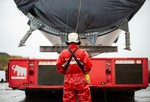11/28/2011
Topic of the Week - Offshore Wind Power Capacity To Reach 64,594 MW By 2020
Offshore wind energy technology has up to now been implemented mainly in Europe, with the UK leading the way in developing offshore wind energy farms and capacity. Large projects in Europe and Asia-Pacific planned in the near future are forecast to drive strong growth in offshore wind energy capacity. By 2010, offshore wind accounted for 3068 MW of energy representing a 47% CAGR increase during the period 2001 to 2010. In 2001, only 96 MW of energy was sourced from offshore wind energy installations.
Offshore wind energy is increasingly being explored as a source of energy due to its high yield from stronger and more consistent winds compared to onshore locations. Offshore wind energy is expanding at a faster rate than onshore installations. In total the wind energy sector has reported increases in capacity from 24,132 MW in 2001 to 198,203 MW in 2010. In 2010, alone, 36,100 MW of additional wind energy capacity was installed highlighting the level of investment in the industry.
Offshore wind technology lacks regulatory framework in addition to issues sourcing skilled personnel, specialist crane vessels and appropriate auxiliary services. In addition, offshore wind farms often have real issues with connectivity to the grid. Offshore wind technology investment is inherently more expensive than onshore equivalents. The increased investment required for offshore installations of around US$3 million to US$3.5 million per MW means that new projects are capital intensive and the recent financial crisis has meant that financing is a little more difficult to obtain for these expensive offshore projects.
In terms of installation, offshore wind turbines and other heavy equipment are transported using barges and are installed using a jack up vessel or floating crane vessel. The vessel carries out operations such as installing the foundation, tower, turbine and nacelle. With an increase in turbine capacity, the weight also increases significantly. Therefore, larger vessels are required based on the weight and dimensions of the wind power equipment. It is the availability of these large vessels which sometimes is a limiting factor in the speed at which wind farms are installed. Only a limited number of vessels are available at any one time.
A sub-sea cable connects the turbines to an onshore substation from where the power is transmitted to the national grid. From the offshore substation, high voltage direct current (HVDC) or high voltage alternate current (HVAC) cables are used to connect to the onshore substation.
To access report, please copy and paste the following link into your browser:
www.companiesandmarkets.com/Market-Report/offshore-wind-industry-growth-potential-hampered-by-issues-in-supply-chain-and-financing-731485.asp
Offshore wind energy is increasingly being explored as a source of energy due to its high yield from stronger and more consistent winds compared to onshore locations. Offshore wind energy is expanding at a faster rate than onshore installations. In total the wind energy sector has reported increases in capacity from 24,132 MW in 2001 to 198,203 MW in 2010. In 2010, alone, 36,100 MW of additional wind energy capacity was installed highlighting the level of investment in the industry.
Offshore wind technology lacks regulatory framework in addition to issues sourcing skilled personnel, specialist crane vessels and appropriate auxiliary services. In addition, offshore wind farms often have real issues with connectivity to the grid. Offshore wind technology investment is inherently more expensive than onshore equivalents. The increased investment required for offshore installations of around US$3 million to US$3.5 million per MW means that new projects are capital intensive and the recent financial crisis has meant that financing is a little more difficult to obtain for these expensive offshore projects.
In terms of installation, offshore wind turbines and other heavy equipment are transported using barges and are installed using a jack up vessel or floating crane vessel. The vessel carries out operations such as installing the foundation, tower, turbine and nacelle. With an increase in turbine capacity, the weight also increases significantly. Therefore, larger vessels are required based on the weight and dimensions of the wind power equipment. It is the availability of these large vessels which sometimes is a limiting factor in the speed at which wind farms are installed. Only a limited number of vessels are available at any one time.
A sub-sea cable connects the turbines to an onshore substation from where the power is transmitted to the national grid. From the offshore substation, high voltage direct current (HVDC) or high voltage alternate current (HVAC) cables are used to connect to the onshore substation.
To access report, please copy and paste the following link into your browser:
www.companiesandmarkets.com/Market-Report/offshore-wind-industry-growth-potential-hampered-by-issues-in-supply-chain-and-financing-731485.asp
- Source:
- Companies &Markets
- Author:
- Posted by Trevor Sievert, Online Editorial Journalist
- Email:
- ts@windfair.net
- Link:
- www.windfair.net/...
- Keywords:
- wind, wind energy, wind turbine, rotorblade, awea, ewea, wind power, suppliers, manufacturerstrevor sievert







